New Account | Seed Mix |
Gift Certificates |AAS Winners |
Gardening Products
SEEDS: Unusual | Annuals | Perennials | Vegetables | Herbs | Trees
Daisy Type Flowers
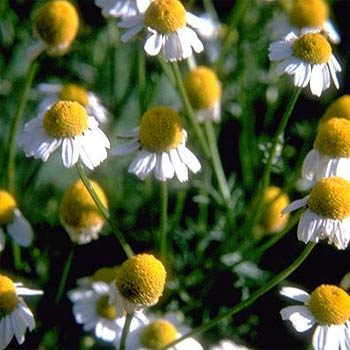
W206 German Chamomile ( Matricaria recutita )
An easy to grow annual with pretty daisy like flowers, the flowers are scented, and only the flowers are used for making tea.
If you want to harvest flowers for making Chamomile tea, it is best to collect flowers on a sunny day (ensuring that the flowers are fully open), then dry them in the sun. Discard the stems and leaves and store the chamomile flowers in an air tight container.
German Chamomile is most often used for medicinal purposes, and is usually administered as a tea. It can also be administered as a compress for external healing and as a bath for babies. Here are a few uses:
Soothes and relaxes at bedtime.
Relieves restlessness, teething problems, and colic in children.
Relieves allergies, much as an antihistamine would.
Aids digestion when taken as a tea after meals.
Relieves morning sickness during pregnancy.
Speeds healing of skin ulcers, wounds, or burns.
Treats gastritis and ulcerative colitis.
Other Uses
Makes a relaxing bath or footbath.
Lightens fair hair and conditions complexion. Make a rinse by simmering 2 teaspoons dried flowers in 8 ounces of water for 15 minutes.
Potpourri (dry flowers face down.)
Parts of plant to use for tea: Flowers only. Taste: A rather pleasant taste, made very nice with a little bit of honey.
If you want to harvest flowers for making Chamomile tea, it is best to collect flowers on a sunny day (ensuring that the flowers are fully open), then dry them in the sun. Discard the stems and leaves and store the chamomile flowers in an air tight container.
German Chamomile is most often used for medicinal purposes, and is usually administered as a tea. It can also be administered as a compress for external healing and as a bath for babies. Here are a few uses:
Soothes and relaxes at bedtime.
Relieves restlessness, teething problems, and colic in children.
Relieves allergies, much as an antihistamine would.
Aids digestion when taken as a tea after meals.
Relieves morning sickness during pregnancy.
Speeds healing of skin ulcers, wounds, or burns.
Treats gastritis and ulcerative colitis.
Other Uses
Makes a relaxing bath or footbath.
Lightens fair hair and conditions complexion. Make a rinse by simmering 2 teaspoons dried flowers in 8 ounces of water for 15 minutes.
Potpourri (dry flowers face down.)
Parts of plant to use for tea: Flowers only. Taste: A rather pleasant taste, made very nice with a little bit of honey.
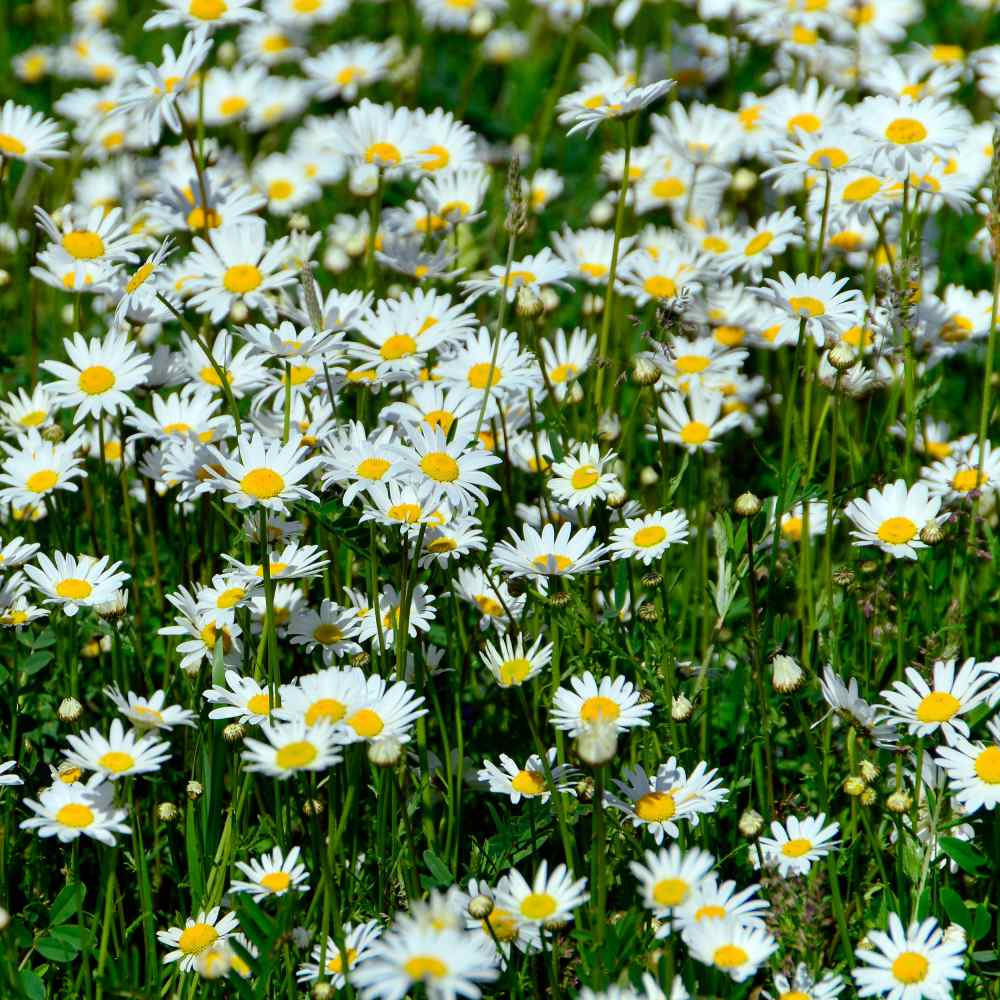
SF084 Roman Chamomile ( Chamaemelum nobile )
Roman Chamomile seeds produce a thick, evergreen perennial herb plant that is very versatile and lovely. Forms a 6 inch mat of sweetly scented, parsley-like, bright green foliage, and it produces tiny, white and yellow daisy-like blooms in the late spring. An herbal flowering carpet comes to life!
This herbal carpet can even be used as a lawn substitute. This species is grown for the famous British Chamomile lawns.
Roman Chamomile plants may deteriorate in very cold or wet winters, but they will most likely recover. Harvest chamomile flowers when they are first fully opened. Use them fresh or freeze them for later use. Another benefit is that the flowers are used in herbal teas and are said to have medicinal properties.
Often used as a ground cover, Roman Chamomile holds soil in place even on slopes, it spreads to fill in gaps, and it blocks out most weeds. It can be mowed (after flowering and set the mower on the highest setting), and it tolerates light foot traffic. This ground cover is unique, aromatic, attractive and is well-suited for covering large areas and can be started by sowing the herb seeds ( Sow on cultivated soil. Sowing Rate: Approximately 5,000 seeds covers 100 square feet. Average Germ Time: 7 - 10 days. Keep moist until germination. Depth: Surface sow, cover lightly with peat moss. )
Attracts honeybees and birds. Young leaves and flowers can be gathered to make a calming tea, both fresh and dried.
Grows well in zones 4-9.
This herbal carpet can even be used as a lawn substitute. This species is grown for the famous British Chamomile lawns.
Roman Chamomile plants may deteriorate in very cold or wet winters, but they will most likely recover. Harvest chamomile flowers when they are first fully opened. Use them fresh or freeze them for later use. Another benefit is that the flowers are used in herbal teas and are said to have medicinal properties.
Often used as a ground cover, Roman Chamomile holds soil in place even on slopes, it spreads to fill in gaps, and it blocks out most weeds. It can be mowed (after flowering and set the mower on the highest setting), and it tolerates light foot traffic. This ground cover is unique, aromatic, attractive and is well-suited for covering large areas and can be started by sowing the herb seeds ( Sow on cultivated soil. Sowing Rate: Approximately 5,000 seeds covers 100 square feet. Average Germ Time: 7 - 10 days. Keep moist until germination. Depth: Surface sow, cover lightly with peat moss. )
Attracts honeybees and birds. Young leaves and flowers can be gathered to make a calming tea, both fresh and dried.
Grows well in zones 4-9.
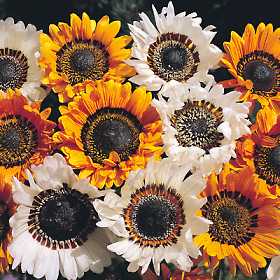
JB249 African Daisy Harlequin Mix ( Arctotis hybrida )
A beautiful strain of African Daisy with large, wonderfully colored flowers ranging from brillant creams, yellows, oranges, reds, crimsons and purples, with different and brilliant color combinations. These are compact plants growing only about 10 inches tall. The plant will tolerate lots of abuse. It can be used in containers, borders, baskets and rock gardens so long as there is sun.
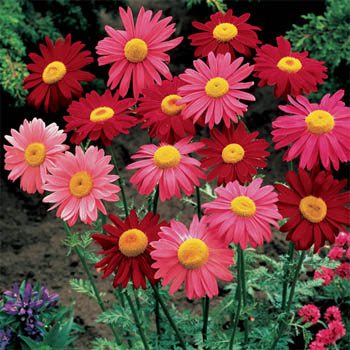
FS505 Giant Painted Daisies ( Tanacetum )
Big 2-3" daisy flowers on long stems reaching 18" tall. Easy to raise and makes excellent cut flowers. Also known as Pyrethum.
Painted Daisies are old-fashioned perennials that have always been popular as cut flowers.
Foliage is bright green and ferny, with upright stems bearing loads of fluffy double daisies, in shades of white, pink or crimson red.
Remove faded flower to encourage more buds to form. Plants may be trimmed hard after blooming to rejuvenate the foliage. Easily divided in spring or fall. These are a nice addition to any sunny border, and also useful in containers or tubs.
For zones 3-7. Grows about 18 inches tall.
Painted Daisies are old-fashioned perennials that have always been popular as cut flowers.
Foliage is bright green and ferny, with upright stems bearing loads of fluffy double daisies, in shades of white, pink or crimson red.
Remove faded flower to encourage more buds to form. Plants may be trimmed hard after blooming to rejuvenate the foliage. Easily divided in spring or fall. These are a nice addition to any sunny border, and also useful in containers or tubs.
For zones 3-7. Grows about 18 inches tall.
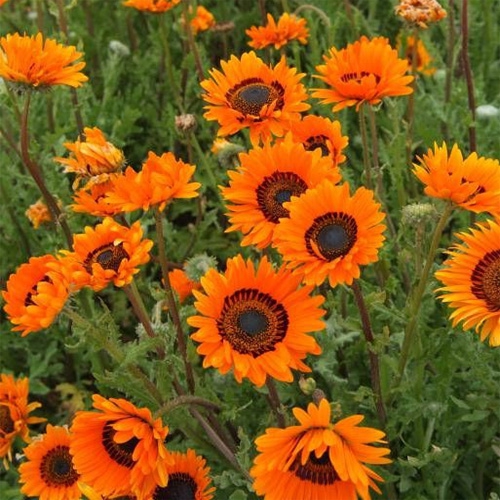
JB181 Orange Monarch of the Veldt ( Venidium Fastuosum Orange )
Grow Venidium seeds for a brilliant display of color all summer and fall. The Venidium flower is in the aster family, and it goes by the common names of Monarch of the Veldt and Cape Daisy. Orange Cape Daisy has silvery-green foliage and large, intensely colored blooms. Native to South Africa and Nambia, and it is cultivated as an ornamental plant for its prized flowers. Cape Daisy flowers are excellent for cutting. Mix Cape Daisy flowers into the border or plant around the vegetable garden, as they are very attractive to beneficial insects and pollinators.
Start seeds indoors in late winter for the earliest blooms. For areas with a longer bloom season, prepare a weed free seedbed outdoors, and sow the seeds directly once frost danger has passed. Thin the seedlings to 12 inches apart. Venidium orange flowers are easy to grow and maintain. Provide full sun, regular water, fertile, well-draining soil, and these flowers will not disappoint you. Care includes deadheading the spent blooms to promote continual flowering. May grow as a perennial in zones 10 and 11.
Start seeds indoors in late winter for the earliest blooms. For areas with a longer bloom season, prepare a weed free seedbed outdoors, and sow the seeds directly once frost danger has passed. Thin the seedlings to 12 inches apart. Venidium orange flowers are easy to grow and maintain. Provide full sun, regular water, fertile, well-draining soil, and these flowers will not disappoint you. Care includes deadheading the spent blooms to promote continual flowering. May grow as a perennial in zones 10 and 11.
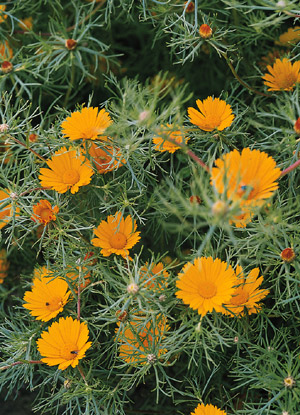
LET560 Criss Cross ( Anthemis arabica )
A great addition to the perennial garden, bushy, feathery foliage, gold daisies, great scent, for bedding or basket.
Also called golden marguerite, this is an erect, clump-forming, shrubby perennial growing to 3 feet tall which features profuse 1.5" diameter, yellow, daisy-like flowers and finely divided, fern-like, aromatic, green leaves which are whitish and woolly beneath. Good fresh cut flower.
A low-maintenance plant that adds long-lasting color and contrast to the summer perennial border. A good choice for areas of the garden that are dry or of low fertility.
Best suited for zones 3-7.
A low-maintenance plant that adds long-lasting color and contrast to the summer perennial border. A good choice for areas of the garden that are dry or of low fertility.
Best suited for zones 3-7.

2578 African Daisy ( Arctotis grandis )
Beautiful white daisy like flowers with steely bluish gray centers. Blooms continuously! Originally from South Africa, loves heat. Long stemmed large flowers, white with blue disk. Annual growing 25" tall.
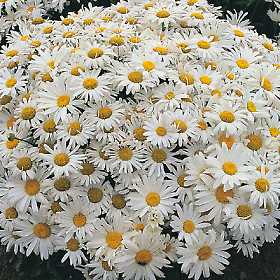
LET935 Marconi Shasta Daisy ( Leucanthemum marconi )
Marconi grows to 3 feet tall and has double white flowers ( 2 to 4 inches
across) and gold centers. Clump forming perennial. Flowers begin blooming in May, with largest show around early June, then continue sporadically until frost. Flower stalks are 2 to 4feet tall making these splendid in borders. Shasta Daisies make excellent cut
flowers, as they are long lasting and hold form and color well. Grows 36" tall.
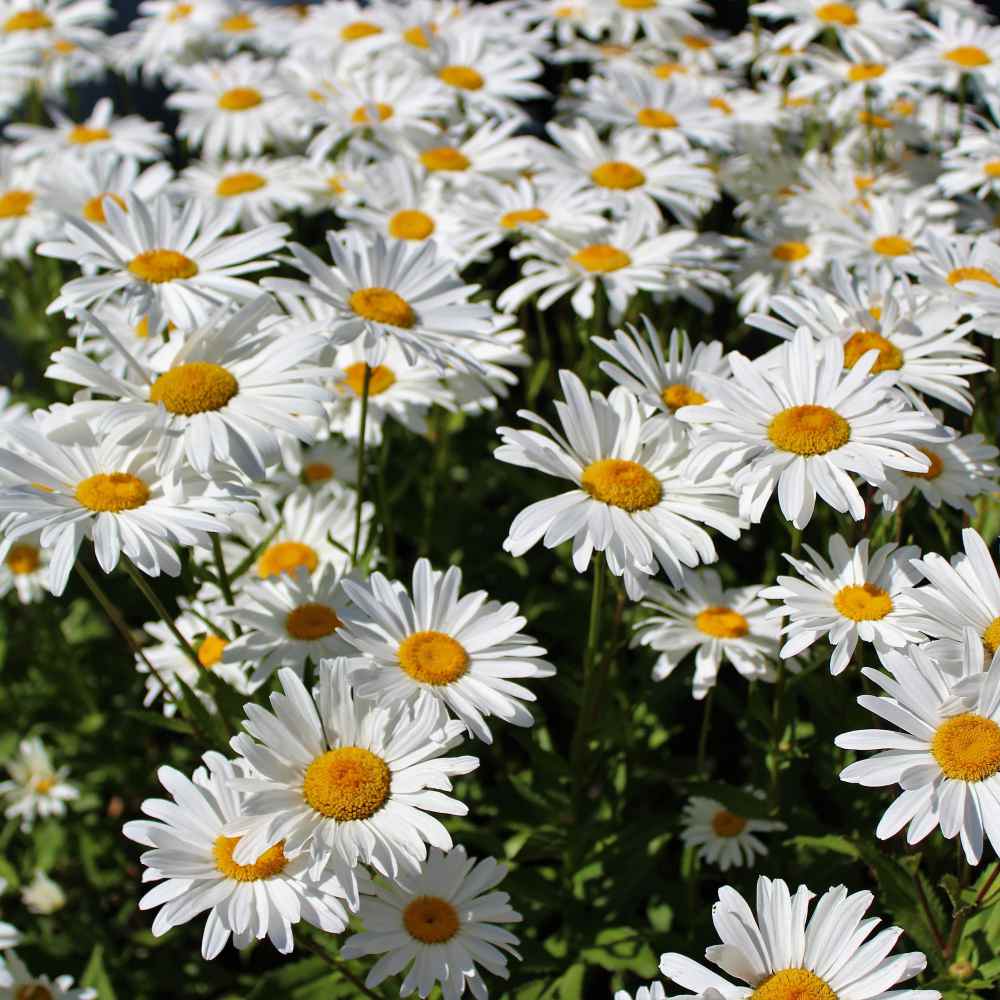
1A458 Shasta Daisy ( Chrysanthemum maximum )
Start seeds to grow this old-fashioned favorite! Chrysanthemum Maximum Shasta Daisy is a mainstay in the perennial flower garden with its large white blooms and yellow centers. Shasta Daisy is a very popular wild flower that will grow in all regions of North America. Chrysanthemums are very easy to establish from flower seeds, and Shasta Daisy flowers are great for cutting and the butterflies love them. Chrysanthemum likes to grow in full sun and well-drained soils. To prolong the bloom pick off flowers as soon as they fade. To prevent overcrowding, divide Shasta Daisy plants after three or four years of flowering.
Shasta Daisy plants are ideal for a wild flower garden's edge or are attractive in butterfly gardens or combined with other perennials or annuals. For cooler climates with short growing seasons, start the Chrysanthemum Daisy seeds indoor 6 - 8 weeks before frost season is over. For warmer climates, sow the Shasta Daisy seeds directly outdoors into prepared beds in the spring after danger of frost has passed. Sow the wild flower seed on the surface and keep moist. Shasta Daisy flowers will not bloom the first year, but grow slowly to get established. It will then be a prolific bloomer in successive years. Shastas are one of the best daisies to grow from wild flower seed! Grows about 32 inches tall. A perennial for zones 3-9.
Shasta Daisy plants are ideal for a wild flower garden's edge or are attractive in butterfly gardens or combined with other perennials or annuals. For cooler climates with short growing seasons, start the Chrysanthemum Daisy seeds indoor 6 - 8 weeks before frost season is over. For warmer climates, sow the Shasta Daisy seeds directly outdoors into prepared beds in the spring after danger of frost has passed. Sow the wild flower seed on the surface and keep moist. Shasta Daisy flowers will not bloom the first year, but grow slowly to get established. It will then be a prolific bloomer in successive years. Shastas are one of the best daisies to grow from wild flower seed! Grows about 32 inches tall. A perennial for zones 3-9.

